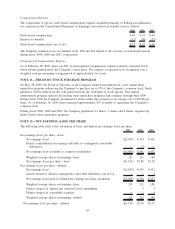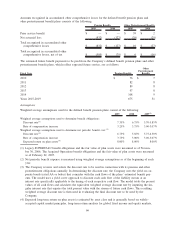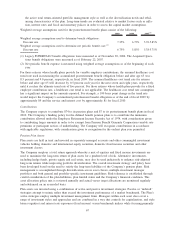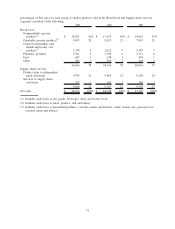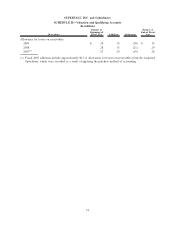Albertsons 2009 Annual Report Download - page 71
Download and view the complete annual report
Please find page 71 of the 2009 Albertsons annual report below. You can navigate through the pages in the report by either clicking on the pages listed below, or by using the keyword search tool below to find specific information within the annual report.
the active total return-oriented portfolio management style as well as the diversification needs and rebal-
ancing characteristics of the plan. Long-term trends are evaluated relative to market factors such as infla-
tion, interest rates and fiscal and monetary polices in order to assess the capital market assumptions.
Weighted average assumptions used for the postretirement benefit plans consist of the following:
2009 2008 2007
(1)
Weighted average assumptions used to determine benefit obligations:
Discount rate 7.35% 6.75% 5.70-5.85%
Weighted average assumptions used to determine net periodic benefit cost:
(2)
Discount rate 6.75% 5.85% 5.38-5.75%
(1) Legacy SUPERVALU benefit obligations were measured as of November 30, 2006. The Acquired Opera-
tions benefit obligations were measured as of February 22, 2007.
(2) Net periodic benefit expense is measured using weighted average assumptions as of the beginning of each
year.
For those retirees whose health plans provide for variable employer contributions, the assumed healthcare cost
trend rate used in measuring the accumulated postretirement benefit obligation before and after age 65 was
8.5 percent and 9.0 percent, respectively, in fiscal 2009. The assumed healthcare cost trend rate for retirees
before and after age 65 will decrease by 0.5 percent each year for the next seven and eight years, respectively,
until it reaches the ultimate trend rate of five percent. For those retirees whose health plans provide for a fixed
employer contribution rate, a healthcare cost trend is not applicable. The healthcare cost trend rate assumption
has a significant impact on the amounts reported. For example, a 100 basis point change in the trend rate
would impact the Company’s accumulated postretirement benefit obligation as of the end of fiscal 2009 by
approximately $9 and the service and interest cost by approximately $1 for fiscal 2010.
Contributions
The Company expects to contribute $74 to its pension plans and $7 to its postretirement benefit plans in fiscal
2010. The Company’s funding policy for the defined benefit pension plans is to contribute the minimum
contribution allowed under the Employee Retirement Income Security Act of 1974, with consideration given
to contributing larger amounts in order to be exempt from Pension Benefit Guaranty Corporation variable rate
premiums or participant notices of underfunding. The Company will recognize contributions in accordance
with applicable regulations, with consideration given to recognition for the earliest plan year permitted.
Pension Plan Assets
Plan assets are held in trust and invested in separately managed accounts and other commingled investment
vehicles holding domestic and international equity securities, domestic fixed income securities and other
investment classes.
The Company employs a total return approach whereby a mix of equities and fixed income investments are
used to maximize the long-term return of plan assets for a prudent level of risk. Alternative investments,
including hedge funds, private equity and real estate, may also be used judiciously to enhance risk-adjusted
long-term returns while improving portfolio diversification. The overall investment strategy and policy have
been developed based on the need to satisfy the long-term liabilities of the Company’s pension plans. Risk
management is accomplished through diversification across asset classes, multiple investment manager
portfolios and both general and portfolio-specific investment guidelines. Risk tolerance is established through
careful consideration of the plan liabilities, plan funded status and the Company’s financial condition. This
asset allocation policy mix is reviewed annually and actual versus target allocations are monitored regularly
and rebalanced on an as-needed basis.
Plan assets are invested using a combination of active and passive investment strategies. Passive or “indexed”
strategies attempt to mimic rather than exceed the investment performance of a market benchmark. The Plan’s
active strategies employ multiple investment management firms. Managers within each asset class cover a
range of investment styles and approaches and are combined in a way that controls for capitalization, and style
biases (equities) and interest rate exposures (fixed income) versus benchmark indices while focusing primarily
67








